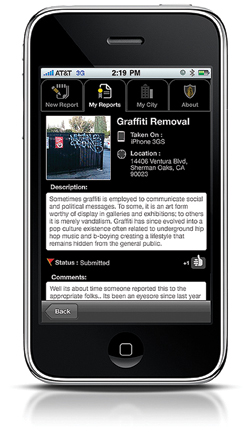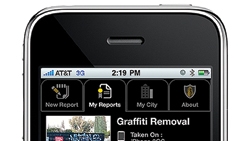Power to the people
The notion of citizens taking an active hand in governing themselves is nothing new. In the United States, it dates back to the late 18th century, when “no taxation without representation” became the rallying cry of the movement that eventually sparked the revolution that spawned a new nation.
What is new is how citizen engagement in government occurs today. While people still attend town-hall and city-council meetings to express their frustrations and concerns, many more people — by an order of magnitude — now interact with their local governments without ever stepping foot into municipal buildings. Instead, they use their smart devices to lodge a complaint or to alert public safety and public works about an incident or problem.
It’s a phenomenon that is expected to grow, fueled in part by the continuing proliferation of smartphones. According to a study released last month by the Pew Research Center, 35% of American adults currently own smartphones; of those in the 25–34 age bracket, 58% own smartphones. There is little reason to believe that those numbers won’t continue to grow in an aggressive fashion.
Social networking also is fueling this new era of citizen engagement, according to Michael Armstrong, CIO for the city of Corpus Christi, Texas.

“Almost all politicians now have Facebook pages, and they’re becoming very comfortable with connecting to people that way,” Armstrong said. “We also have a group of young people coming up who communicate entirely differently than the past several generations. They are connected all the time, and they are social. But they don’t connect face to face — or even voice to voice — anymore. Instead, they’re using the technologies that are available to them on their computers and, increasingly, on their phones.”
Corpus Christi joined numerous other cities in making available to its citizens a downloadable application for Android, iPhone and Blackberry devices that was developed by Los Angeles–based CitySourced.
Dubbed CC Mobile, the app lets citizens report potholes, graffiti, traffic accidents, open manhole covers, abandoned or illegally parked cars, trash problems, and more as they witness them.
“They’re now invested in helping to operate their city and, in a lot of cases, contributing to the decision-making process,” Armstrong said. “That has been real difficult up to this point. You had to show up at council meetings, which takes a lot more time than people were willing to devote. Now, they can do this very quickly, without changing their daily schedules.”
The city of Boston began to look at how it could leverage social media about three years ago, according to Don Denning, the city’s public-safety chief information officer. It started with Twitter, because “it was all the rage at the time,” he said.

Once the city’s police-dispatch center began to send out tweets — crime alerts, crime-stopper tips, road closures and the like — something interesting happened.
“People started to interact and ask questions,” Denning said. Soon, the police department had “thousands and thousands” of followers. That got the attention of other departments within the city, which also started to tweet.
The success with Twitter led Boston to look at how it could leverage other social media opportunities, most notably Facebook. One of the first efforts used that medium as a firefighter recruiting tool.
“When you hire firefighters, there is a maximum age,” Denning said. “You want to reach the 18–30 age range to get as many good candidates in the hiring pool as possible. Facebook met the demographics.”
Eventually, the city began to think about how it could further leverage the growing interaction its departments were having with the citizenry. It also wanted to streamline and improve the process.
“The city was investing significant resources to support its 24-hour ‘mayor’s hotline,’” Denning said. “It needed to connect the call-taking to the service delivery. Calls for street lighting, trash collection and potholes all went to different call desks, and none of the processes were automated.”
So, the city created and staffed a centralized call center and deployed a customer relationship management (CRM) system to support it.
“It was sort of 311 for Boston and was branded Citizen’s Connect,” Denning said. “The system took the calls, created work orders and generated reports so that department heads could see what was going on.”
The next logical step was to create a smartphone app, which it did, working with third-party developer Connected Bits.
Meanwhile, the city of Seattle also is pursuing citizen engagement, and leverages a variety of media — first and foremost, its own website.

“We still believe that the website, Seattle.gov, is the definitive source for information,” said Bill Schrier, the city’s chief information officer. So, the city pushes most of the information it disseminates to the citizenry via the site and the “Seattle Channel,” which was named the top municipal TV station three of the last four years, Schrier said.
However, the city’s police, fire, sanitation and transportation departments all actively tweet, maintain a Facebook presence and produce their own blogs.
“When one of these departments hears about an incident, they’ll tweet about what’s going on,” he said. “Then they’ll link that tweet back to the department’s blog, where people can go to get additional information. It’s a good way to get information out to the citizens and avoid being inundated with calls.”
Though Seattle doesn’t have a smartphone app just yet — it is developing a CRM system and has issued a request for proposal concerning the app — it does have something called “My Neighborhood Map” that can be found at the city’s website. Citizens can use this tool to discover the locations and URLs for Seattle’s parks, as well as get information about various cultural opportunities and events. They can even access actual 911 calls.
“Fire is pretty much up to the minute, but we delay access to the police calls five to six hours, because we don’t want a bunch of people going to the [crime scene],” Schrier said.
Sometimes such transparency can backfire.
“People also can pull up information on all of the crimes that have happened in their neighborhoods — the assaults and burglaries, and the lesser crimes like graffiti,” Schrier said. “They can even pull up the redacted police report, if one exists. Sometimes people say to me, after looking at the map, ‘I never realized there was so much crime in my neighborhood.’”
Despite this, there is much more upside to such transparency, as a well-informed citizenry is a citizenry that is better equipped to help itself, according to Schrier. For instance, if they know that a rash of car break-ins has occurred in their neighborhood, they can take appropriate precautions.
“Forewarned is forearmed,” Schrier said.
Indeed, while the confluence of technology and social networking is the primary driver behind the increase in citizen engagement, a desire for greater transparency in government is a close second, according to Alan Shark, executive director and CEO of the Washington, D.C.–based Public Technology Institute.
“People want to see more openness. They want to know what’s going on,” Shark said.
A study conducted last year by the Pew Research Center’s Internet and American Life Project supports Shark’s contention. According to the survey report, 40% of adult Internet users in the U.S. have gone online for data regarding government spending and activities. In addition, 31% of adults have used blogs, social-networking sites and other online media to keep apprised.
The message seems to be resonating at all levels of government. For instance, President Obama issued a directive shortly after taking office that said government not only should be transparent, it also should be collaborative and participatory — a notion that speaks directly to the concept of citizen engagement.
Governments benefit greatly when they are transparent and their citizens are engaged, according to Armstrong, who admitted that he’s a late-comer to this way of thinking.
“Up until this point, I never understood why someone would want to have a relationship with government. The belief was that they want their services when they want them, and leave me alone after that,” he said. “But now, we’ve come to realize that, when citizens are involved in government, it gives them a sense of ownership … . And, when governments are more open, they are more trusted.”
Beyond trust, other tangible benefits are being realized from the increased interaction with citizens. For instance, the CC Mobile app not only lets citizens report problems, it keeps them in the loop about how the relevant municipal agency is handling the complaint. When citizens see even marginal progress, they tend to be less agitated.
The app also provides information to municipal agencies that enable them to operate more efficiently, according to Kurt Dadarics, director of business development for CitySourced. For instance, knowing the specifics about the complaint lets an agency quickly decide how to respond.
“It also generates a lot of meta data that enables agencies to automate their response to a service request,” he said. “They no longer have to send a truck out to verify the complaint.”
Corpus Christi, for instance, has modified CC Mobile to integrate it with the city’s work-management process. When a citizen files a complaint via the app, it automatically is placed into queue, instead of into somebody’s e-mail inbox to be dealt with later, Armstrong said.
“That speeds the process up,” he said. “And, when they send the report in, they’ll get an e-mail back with a tracking number.”
Perhaps more important is that the GIS capability lets government agencies analyze trends and patterns they would miss otherwise, according to PTI’s Shark.
“The city of Denver encountered a real problem with graffiti, and they responded by dispatching an anti-graffiti force all over the city,” he said. “But, when they started analyzing where the postings were coming from, they realized that they were all coming from one basic area. Once they figured that out, they were able to concentrate their efforts, which was much more efficient for the government and got better results.”
According to Dadarics, Los Angeles had a similar experience.
“They did a geospatial analysis of all the graffiti reports around L.A. and found that 80% of them were within a mile of a freeway,” Dadarics said. “So, they were able to beef up police patrols to look for vandals around freeways.”
Another benefit of geo-tagging the data is that it allows governments to transmit warnings and alerts based on citizens’ location relative to an incident. In other words, those in the immediate area would receive one set of instructions, while those outside of the area would receive another set.
“For example, we may have an incident at a refinery where traffic may be blocked or there may be some danger to the people living nearby,” Armstrong said. “In fact, we had one of those recently where one of our refineries was doing something called flaring, which involves a lot of open flames. We sent out a message that said that there was no accident and no danger.”
This not only makes incident response more efficient and effective, it also reduces the potential for panic ensuing. The idea is that an informed citizenry is a safer and calmer citizenry. It also “helps to keep the call volumes down,” he said.
On the topic of public safety, leveraging the populace in the aftermath of a disaster is one aspect of citizen engagement that is beginning to be explored. The idea of citizens performing the role of “first first responder” is appealing on several fronts, according to Armstrong.
“We didn’t really think about this piece until we started playing with the application,” he said. “But we can use this to very quickly assess where the damage exists and where hazards still exist. We can get pictures of those; we can map those. That will help us to use our scarce resources better.
Perhaps the greatest long-term benefit of the citizen-engagement phenomenon is that it provides governments with the ability to treat constituents less as citizens and more as colleagues.
“The citizenry actually becomes an extension of our response team in those situations,” Armstrong said. “That will help us react in a much more rapid manner and hopefully get things back to normal quicker than we would have otherwise.”
Related Stories

















